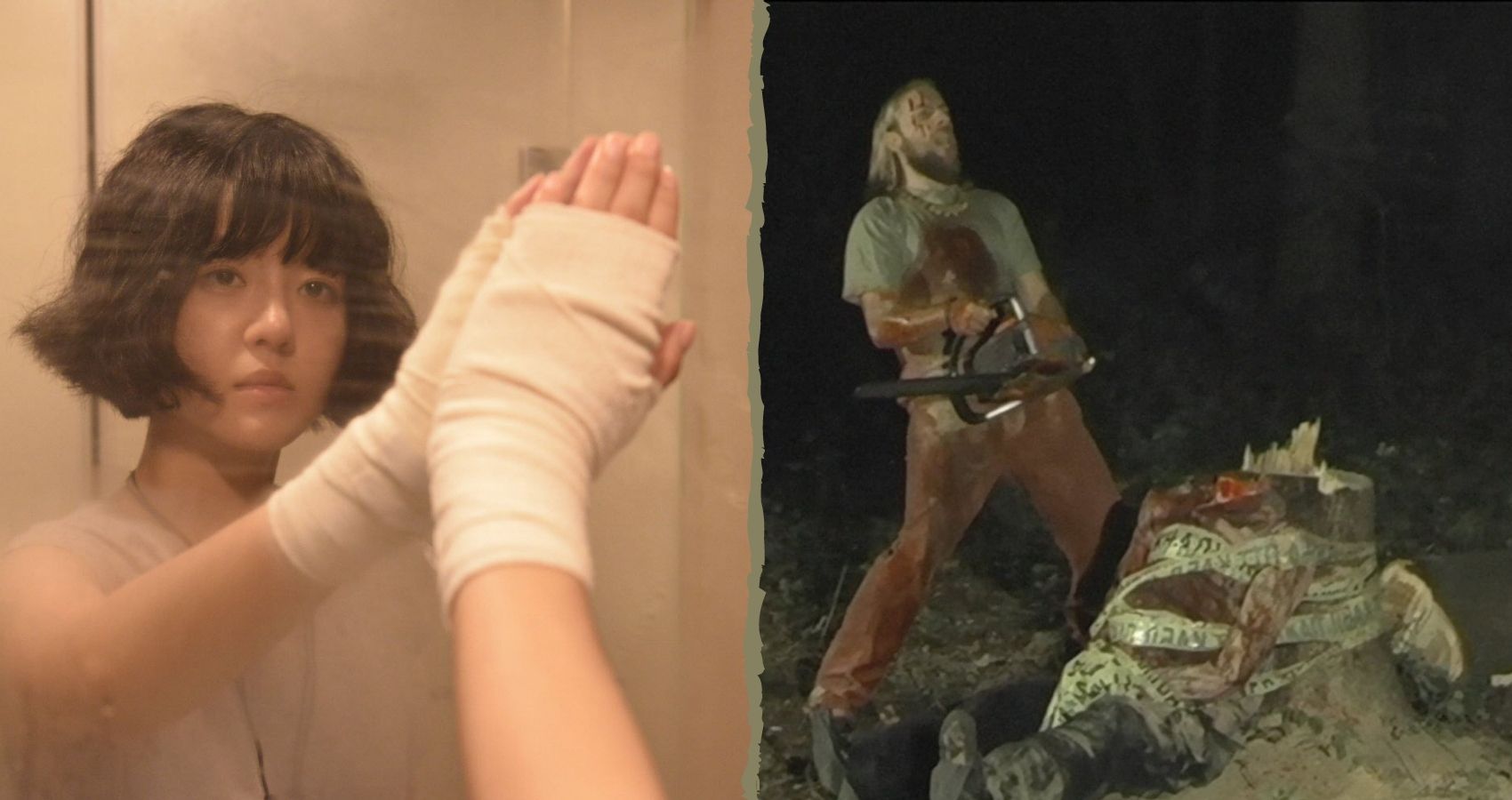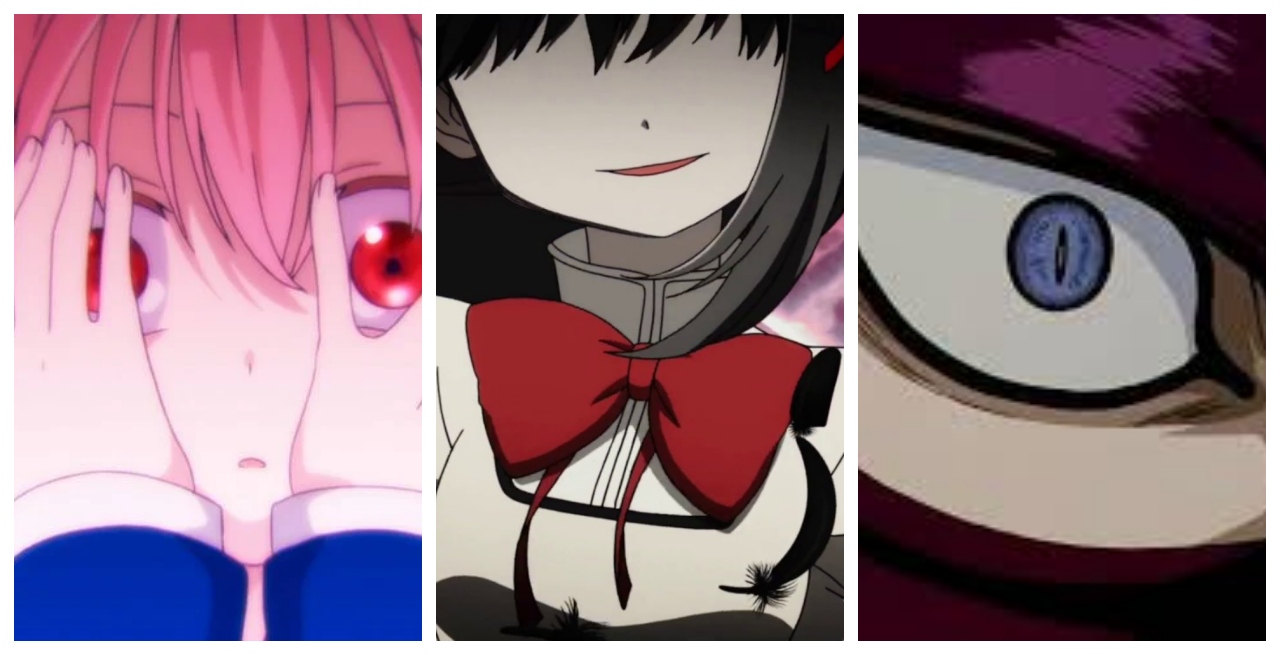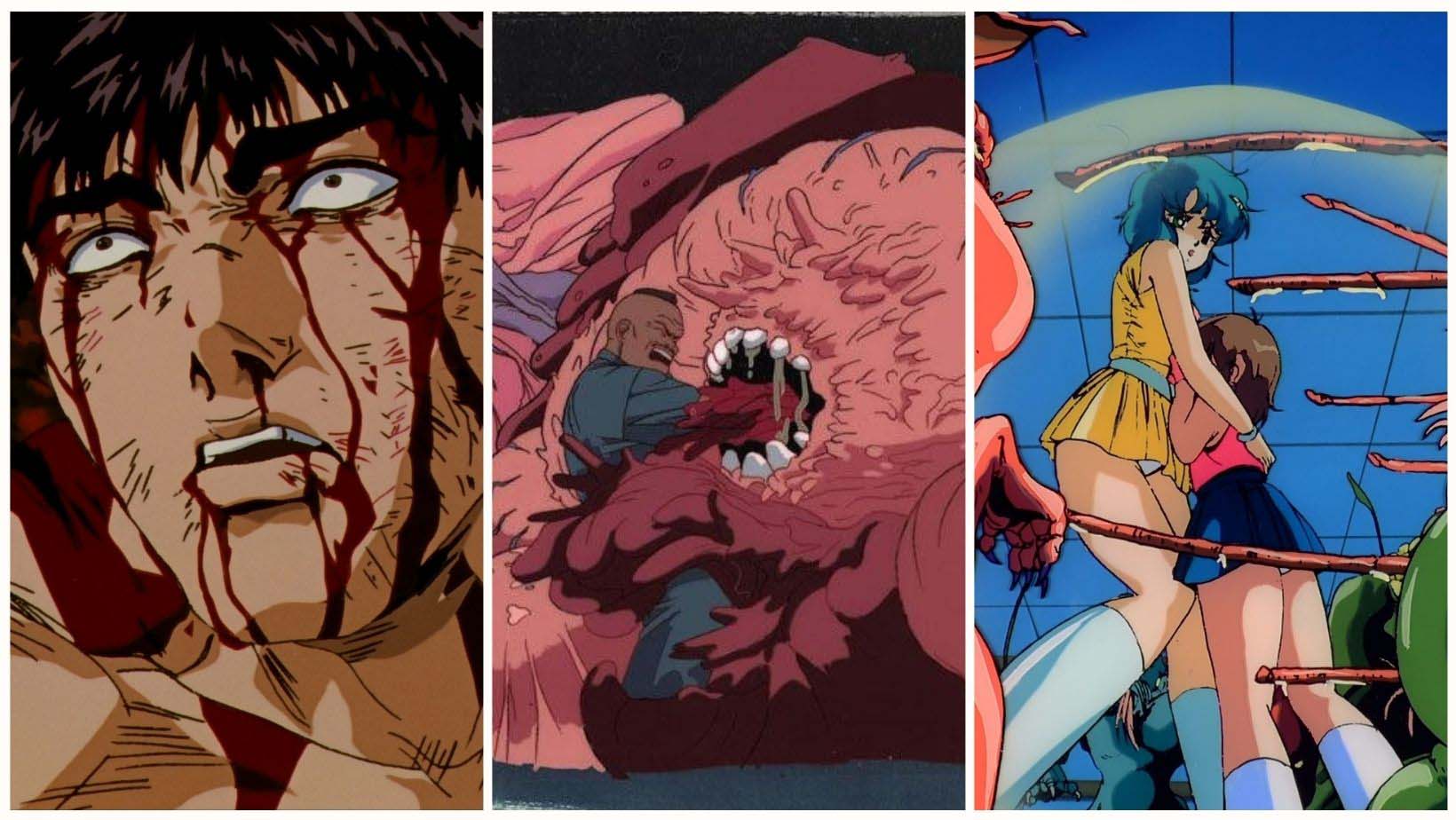
When it comes to horror subgenres, body horror is, by far, the most impressive visually – the loss of bodily autonomy in the most horrendous and intimate way. As such, this element is incredibly strenuous to effectively pull off in live-action cinema, usually requiring both a large budget and tremendously skilled special effects teams to be able to realise the director’s gory vision on the screen efficiently.
Consequently, due to the intensive demands of specialist SFX or expensive CGI, mediums such as animation seem the logical solution in exploring such a genre. Animation is an effective way to present a visually striking display of horror in the absence of a huge budget and crew – artwork suffice to enable imaginative flexibility from the realistic constraints of live projects. Although this genre is still prevalent today, there is a certain charm about the synthesis of graphic violence and the aesthetic of anime from the 80s and 90s. Thus, I have decided to create a list of eleven of the best body horror anime from this time period – perfect for those interested in looking more in-depth at this instinctively terrifying genre and its history in anime (Note: list order does not insinuate any sort of rankings)
11 Best Body Horror Anime Of The 80s & 90s
Genocyber (1994) by Koichi Ohata
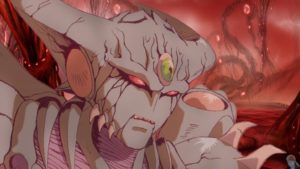
“While the nations of the world are trying to abolish warfare and the existence of armies, private companies are creating their own armies. The Kuryu group has been trying to create the perfect weapon; human beings capable of mastering their “mind shadow” named Vajura. They were hoping for an edge, but the experiment seemingly went wrong. However many years later a strange young girl named Elaine escapes the Kuryu research facility. Confronted with hostile gangs, hunted by cybernetic agents, and other strange members of the Kuryu group she is forced to become the Genocyber, the first Vajura. Confronted again and again with the experiments of the Kyuryu group and the inhumanities of mankind, she has no choice but to continue to fight, but at what cost?”
A well-known cult classic, synonymous with body horror and considered one of the most graphic mainstream anime around. The incredible attention to detail of the violence is by far one of its strengths, although a convoluted story and weak, short-lived characters make the anime feel cluttered – weakening any overall narrative. That notwithstanding, this anime’s focus is firmly on the captivating carnage, and oh boy… does this anime not hold back: live vivisections, child murder as well as some of the most vivid, relentless depictions of grotesque gore in the medium. The unwavering violence was unfortunately divisive to the anime community, being both despised and praised by fans, as well as being banned in a number of countries including Japan. Consequently, Genocyber is subjective in nature and, though not for everyone, this anime will certainly entertain lovers of body horror and extreme anime from this era.
Akira (1988) by Katsuhiro Ôtomo
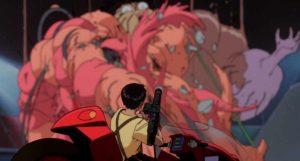
“Following the disaster wrought upon the world by a mysterious being called ‘Akira’, Neo Tokyo is now in social and economic turmoil. In such a decaying city, feisty Kaneda and his shy friend Tetsuo survive by running around in a biker gang, chasing local rivals and generally evading the police. Everything changes, however, when Tetsuo crashes into a strange-looking boy during a bike chase, and the military ends up taking him away. When he eventually returns to his friends, he’s no longer the same weak little boy they always knew – in fact, a military experiment has turned him into something beyond human imagination. While the military is intent on reclaiming its specimen at any cost, Tetsuo is sick of being bullied around and is about to show everyone, including his friend Kaneda, exactly who is boss.”
Akira is, in many respects, the greatest of all time when it comes to anime. However, fans hold this anime in the highest regard due to its incredible depiction of body horror. The truly horrendous transformation Tetsuo undergoes during the film’s third act is a sight to behold, being unlike anything seen in mainstream cinema at the time. His transformation into an amorphous eldritch abomination is uniquely unnatural by design yet beautifully fluid, accomplished via amazingly detailed hand-drawn cell animation. This technique successfully captures the grandiose scale of this unrelenting horror in a more effective way than any other medium could, resulting in a masterpiece of film and a must-see for anyone who hasn’t yet.
Fight! Iczer One (1985) by Toshiki Hirano
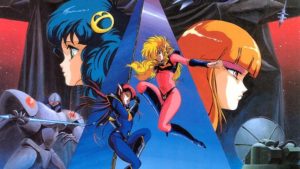
“Earth has a new problem: the Cthuwulf, an all-female race of aliens who are set on invading and conquering the blue planet. Luckily for humanity, Iczer-One, a rebellious woman made by the Cthuwulf, comes to save the day. However, her powers cannot be released without synchronizing with a human being, and thus, she chooses Nagisa, a whiny high-school girl who wants nothing more than to stay out of trouble. Can Iczer-One and the bumbling Nagisa save the human race and defeat the evil Big Gold?”
A personal favourite of the genre, a non-stop gore ride fills the first half of Fight! Iczer One as an alien race destroys the earth and its populace metamorphose into hideous, twisted mutations of their former selves, and continue the destruction of the human race. However, this gory action seems to fade to the background as the second half focuses on its enthralling story which includes space mech battles alongside off-brand lightsabre battles. Despite this lack of grisly violence towards its conclusion, this entry is one of the stronger examples of body horror anime and a must-watch – even those who aren’t the biggest fans of horror can enjoy this delightful display, with a creditworthy story and captivating characters.
Lily C.A.T (1987) by Hisayuki Toriumi
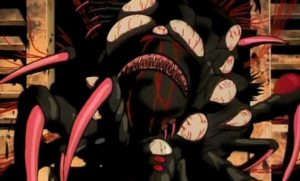
“In the distant future, employees of the Syncam Corporation board a spaceship bound for a newly-discovered planet; while the voyage will take twenty years, deep sleep capsules ensure that the occupants’ age only a single year. Now, that time has passed and the crew awakens, only to discover a frightening partial transmission from headquarters: two of them are not employees – they are criminals. One by one, members of the group soon begin to die for unknown reasons; and what’s worse, the bodies begin to disappear. Now, these men and women must race against the clock to discover the fakes in their midst, find out the reason behind the deaths, and most importantly, stay alive at all costs!”
Being set in the recess of space, Lily CAT begins with a slow pace and a bewitching mystery afoot. Steadily introducing the cast of characters and story, the focus gradually moves onto unscrupulous scenes of body horror sparingly at first. Admirably, it successfully creates and maintains a consistent atmosphere full of dread. Lily CAT pays homage to (though mostly derided as a rip off) Ridley Scott’s Alien (1979) and John Carpenter’s The Thing (1982), though director Hisayuki Toriumi has stated his intention was to make a Baké-Neko or yōkai cat-themed film. Nevertheless, Lily CAT deserves its high regard by the anime community as an enticing entry into both the body horror and space opera genres.
Urotsukidoji: Legend of the Overfiend (1989) by Hideki Takayama
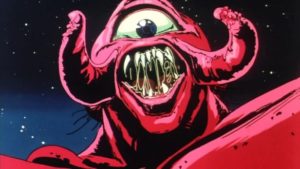
“The relative coexistence of the human world, demon world and beast world is soon to be disrupted by The Overfiend, an immensely powerful demon who’ll be reborn after 3000 years to remake the world to his own liking.”
Being notoriously known for its graphic adult content, Urotsukidoji: Legend of the Overfiend is one of the more risqué choices on this list. Disregarding the stigma surrounding it, the anime has an incredible display of visceral body horror scenes, accompanied by an intriguing, apocalyptic story to boot. The sheer scale of the destruction to the world and humanity itself only being compounded by the savagery exhibited. This anime deserves its place on top anime lists, worthy of exploration by those who are morbidly curious. Although censored versions of this anime are available for those who are not interested in the more adult scenes, this comes at the cost of some of the more violent scenes.
Maryuu Senki (1987) by Hiroaki Motoigi
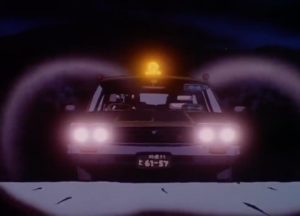
“Once upon a time, there was a certain family having strong influence on the rule of the Imperial Court. They had their own might called “Kidou,” and yet got hated because of the might itself. At last, the patriarch of the family was entrapped to his death, and all the family was doomed to ruin… The present day — the surviving descendants of this family, now calling themselves “Kidousyuu,” schemed to resurrect their murdered patriarch once again, and the ferocious evil spell went into action.”
Contrary to other choices on this list, there is a deep level of historical Japanese mysticism and folklore when it comes to Maryuu Senki’s story. Tying Shinto, Buddhism and Hindu mythology geographically to Japan with extensive historical research. Its use of body horror compounding the frailty of man against legendary Demons and other mythic creatures – even including an early representation of Romero-esc zombies that was unseen at the time. Although its convoluted story can drag on at points, slowing the pacing to a crawl, Maryuu Senki is still a notable addition to the body horror genre and worth checking out for fans.
Berserk (1997) by Naohito Takahashi
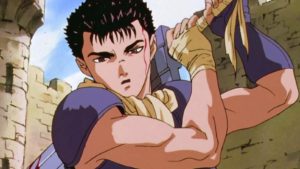
“Born beneath the gallows tree from which his dead mother hung, Guts has always existed on the boundary between life and death. After enduring a terrible childhood, he spends his adulthood in brutal combat, pitting his strength against others in order to build his own. Life is simple enough for Guts until he meets Griffith, the inspirational, ambitious, and beautiful leader of the mercenaries, the Band of the Hawks. When Guts loses to Griffith in a duel, he is forced to join the group, and, despite himself, finds a sense of camaraderie and belonging amongst them. However, as Griffith leads his soldiers from victory to victory, the bloody wars and underhanded politics reveal a side to him that nobody quite expected. Can Guts, a simple warrior, defend those who have come to mean the most to him, all the while struggling not to lose to the darkness he has carried with him his entire life?”
The entire series is full of violent scenes, from the brutality of medieval warfare to the harsh realities of medieval-esque life. Berserk evolves into an entirely different entity in the final episodes after the Eclipse begins, its true colours only just revealed for the first time in an unforgettable scene that overwhelms the senses with the sheer scale of horror to behold. Watching everything that our protagonists have worked towards over the series come crashing down in an explosion of blood and gore, the well-crafted, endearing characters all snuffed out in an instant – makes for an incredibly shocking scene overall and provides an unforgettable beginning to a phenomenally dark story. If you need an entry point to the series, this is the perfect place to start.
Violence Jack: Evil Town (1988) by Ichirô Itano
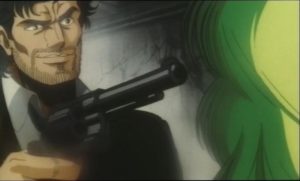
“Six months ago, a massive earthquake sunk a massive Japanese city into the ground, burying it from the outside world. The survivors split themselves into three groups: A, with normal salarymen; B, with criminals and lunatics led by the towering Mad Saurus; and C, an all-female group. However, once food supplies began to dwindle the once-kind men of the A group brutally gang-r*ped the women of the C group, causing the ladies to seal themselves up deep within the ruins. Now, the A group is working towards digging their way to the surface when they unearth Violence Jack, a massive giant. Though the A group wants Jack to help defend them against the B group, he ultimately chooses to protect the C group against all of the others. A bloody civil war approaches – will anyone escape alive?”
The Violence Jack series is well-known for its… well, violence, but Evil Town definitely ranks number one in the series for its explicit depictions of body horror. It includes scenes of cannibalism and ne***philia as completely unhinged violence, even featuring shocking gang r*pe that is difficult to watch due to the sheer volume of torture on display at once (even the censored version forgot to censor everything). Furthermore, being littered with the usual gore expected of the series, with Jack eviscerating his enemies with his iconic jack knife in an absolute bloodbath, elevates this film above the others for the unrestrained brutality exhibited.
Barefoot Gen (1983) by Mori Masaki
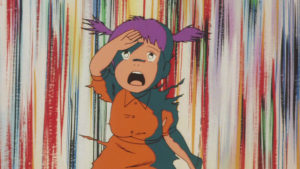
“The year is 1945, and the Japanese war effort is grinding to a halt. In Hiroshima, the Nakaoka family is working hard to survive in the midst of poverty and persecution. With his father constantly working, six-year-old Gen has been left in charge of his family, yet stays relentlessly optimistic in the face of hardship. Then, on August 6th, the atomic bomb Little Boy detonated in the center of town, and the people’s lives were changed forever. As Gen struggles to cope with the horrific event, his youthful innocence and refusal to give up brings a renewed sense of hope to those around him…”
Though not horror, per se, certain scenes have become well-known in the anime community for its breathtaking depiction of body horror that is strangely real. Its representation of the atomic attack on Hiroshima by the American army during the Second World War and the horrific repercussions of the people trapped inside the blast zone, victims melted and vaporized by the blast. The explosion shows no mercy as this beast destroys men, women, children, and animals indiscriminately, unabashedly displayed for all to see in the most nuanced manner. This brazen statement against war and atomic weapons is powerful in its message, compounding the realisation that this work cannot be dismissed as a work of fiction but a historical event that must not be forgotten.
Bio Hunter (1995) by Yûzô Satô
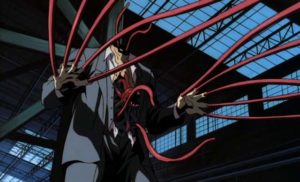
“Koshigaya and Komada are professors by day, but at night, they are Bio Hunters. Their mission? Hunt down people infected with the elusive Demon Virus, and destroy it. Things become complicated when the two become entangled with the fate of Sayaka, a woman whose grandfather is a famous psychic. With powerful enemies on their trail, they must find Sayaka’s lost relative to hear his prophecy or die trying!”
A unique entry, this anime takes a scientific approach to explain the reasoning behind this gruesome metamorphosis from human to unholy abomination rather than just brushing over this fact. An unknown virus infects the human genetic code and turns people into bizarre monsters who have demonic powers, causing them to go on a gore-fuelled rampage through the city streets. Unscrupulously fast-paced, this anime moves at break-neck speed towards its conclusion – being only an hour in length, this feels like a detriment to the story and possible rampages that could have been. Despite this, Bio Hunter is still an entertaining addition to the genre that merits a viewing from fans looking for an action-packed thrill ride.
Wicked City (1987) by Yoshiaki Kawajiri
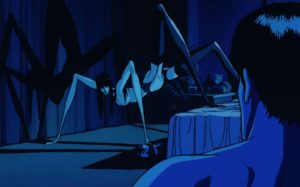
“There has been peace between the worlds of the mortals and the supernatural for centuries, but the balance is now being threatened. The Radical elements from the Supernatural world are crossing over into the mortal universe for the purpose of destroying the peace forever!”
An interesting mix of action, body horror, and political thriller, Wicked City is possibly one of the most stylish entries on this list. With a breathless pace and a film noir style, the anime is brimming with immensely polished action sequences. Full of malformed demon “Radicals” committing heinous acts of terrorism on the populous, effectively tying this enthralling story of political struggle between two species together with its more violent scenes – a mix of sexual elements and body horror in an elegant duality. The creature design is reminiscent of John Carpenter’s The Thing (1981) as a deep-seated inspiration, though these monsters all seem to have their own original, terrifying designs. An absorbing piece of horror, this anime still holds its place as a true classic.
More Lists
With the year drawing ever closer to its conclusion, we cast our mind’s eyes back on the monumental releases over the past 12 months. Join us at Grimoire of Horror… Within the medium of cinema, where every frame is meticulously crafted to evoke emotions and ignite imaginations, titles serve as a gateway to the world within. It is not merely… As an aficionado of the dark side of cinema, I am constantly seeking out new films. While on my journey I come across lists featuring the worlds most extreme and… 2023 has been quite the year for new releases, from sci-fi thrillers, to splatter horror, to sequels and remakes out the wazoo, the year has seen a wide variety of… Sometimes love makes you crazy, and sometimes makes you want to stab someone right in the middle of their chest. Just as the Japanese term defines it, a “yandere” is… It’s that time of year again when it’s dark at 2 pm and colourful lights and Christmas music assault the senses. But fear not, as we have a list of…Grimoire of Horror’s Top Films of 2023
[April Fools] 10 Most Beautiful Titles in Cinema – Beauty is in the Eye of the Beholder
10 Extreme & Disturbing Films You Probably Have Not Seen
Extreme Cinema of 2023 – Some of the Best Releases of this Year
Top 7 Yandere Anime Characters That Are Not Yuno Gasai
11 Best Christmas Horror Films – Tree-mendous Scares Aplenty

Hey there, I’m Jim and I’m located in London, UK. I am a Writer and Managing Director here at Grimoire of Horror. A lifelong love of horror and writing has led me down this rabbit hole, allowing me to meet many amazing people and experience some truly original artwork. I specialise in world cinema, manga/graphic novels, and video games but will sometime traverse into the unknown in search of adventure.


